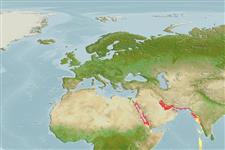>
Atheriniformes (Silversides) >
Atherinidae (Silversides) > Atherinomorinae
Etymology: Atherinomorus: Greek, atherina, the Greek name for the eperlane + Greek, moros = silly, stupid (Ref. 45335).
Environment: milieu / climate zone / depth range / distribution range
Ecología
marino asociado a arrecife. Tropical
Western Indian Ocean: endemic to the Red Sea and has invaded the eastern Mediterranean through the Suez Canal.
Tamaño / Peso / Age
Maturity: Lm ? range ? - ? cm
Max length : 13.3 cm SL macho / no sexado; (Ref. 58474)
Short description
Claves de identificación | Morfología | Morfometría
Espinas dorsales (total) : 5 - 7; Radios blandos dorsales (total) : 8 - 10; Espinas anales: 1; Radios blandos anales: 11 - 15; Vértebra: 40 - 44. This species is distinguished by the following set of characters: lateral process of premaxilla very low and wide; upper margin of dentary almost flat distally, no distinct tubercle at the posterior end; posterior tip of the upper jaw reaching to or exceeding a vertical through anterior margin of the pupil, and not reaching to a vertical through center of the pupil; teeth on endopterygoids large, forming distinct ridges; anus located around posterior tip of the pelvic fin; lower gill rakers 20-23; midlateral scale count 39-43; lower margin of midlateral band reaching to or just below ventral end of the midlateral (third) scale row at the level of the anal fin origin (Ref. 58474).
Feeds on zooplankton, small bottom-living invertebrates (Ref. 5980).
Life cycle and mating behavior
Maturities | Reproducción | Spawnings | Egg(s) | Fecundities | Larva
Kimura, S., D. Golani, Y. Iwatsuki, M. Tabuchi and T. Yoshino, 2007. Redescriptions of the Indo-Pacific atherinid fishes Atherinomorus forskalii, Atherinomorus lacunosus, and Atherinomorus pinguis. Ichthyol. Res. 54(2):145-159. (Ref. 58474)
IUCN Red List Status (Ref. 130435)
Threat to humans
Harmless
Human uses
Herramientas
Special reports
Download XML
Fuentes de Internet
Estimates based on models
Preferred temperature (Ref.
123201): 24.7 - 29.4, mean 27.1 °C (based on 78 cells).
Phylogenetic diversity index (Ref.
82804): PD
50 = 0.5005 [Uniqueness, from 0.5 = low to 2.0 = high].
Bayesian length-weight: a=0.01122 (0.00514 - 0.02450), b=3.04 (2.87 - 3.21), in cm total length, based on all LWR estimates for this body shape (Ref.
93245).
Nivel trófico (Ref.
69278): 3.3 ±0.4 se; based on size and trophs of closest relatives
Resiliencia (Ref.
120179): Medio, población duplicada en un tiempo mínimo de 1.4-4.4 años (Preliminary K or Fecundity.).
Fishing Vulnerability (Ref.
59153): Low vulnerability (10 of 100).
